Written by Megan Turner – TPDDL Student Worker;
Edited by Hannah Ayala – Extension Assistant
Have you noticed strange bumps or swelling on your tree leaves? There could be something living in there! More than 2000 species of insects in the United States create these bumps, properly termed galls, to protect their young while they are developing. While most commonly caused by tiny wasps, they can also be caused by other insects, mites, nematodes, bacteria, and fungi. Eighty percent of galls reported in the US are found on oaks. Considering how many oaks we have here in Texas, it’s likely you have seen them before. Other common hosts include hackberries, roses, and their relatives.
Recently in the lab a Hackberry with nipple galls was observed. These specific galls are caused by psyllids, a jumping plant louse insect. The adult female psyllids lay eggs on the underside of newly formed leaves in spring. After two weeks the eggs hatch and the baby nymphs begin to suck-feed on the leaves. The chemicals released from the insect feeding initiate gall formation around the feeding nymphs. The gall protects the developing insects and keeps them safe from harsh environmental conditions, predators, and pesticides. The nymphs mature and emerge from the galls as adults in the fall. The empty galls can then become homes to beneficial insects.
Hackberry Nipple Gall
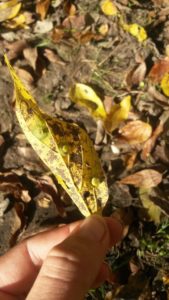
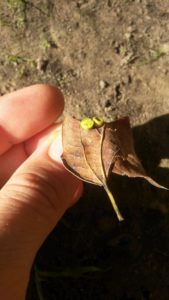
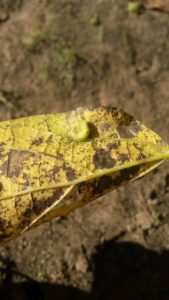
Close ups of galls caused by psyllids on Hackberry leaves.
Galls come in a wide variety of shapes and sizes and are usually named based off of their appearance, such as wooly, nipple, hedgehog, and pocket vein galls. The look of the gall is determined by the type of insect and the chemicals it secretes. Galls can be considered a commensal relationship, where one partner benefits (the gall maker) and the other is unaffected (the host plant). Most gall-makers do not harm the host but some heavy infestations of certain species may cause aesthetic damage, including leaf discoloration, early leaf drop, or twig drop.
Control measures are usually not warranted for galls. However, if they are considered an eyesore, affected plant parts can be removed by hand or pruners and discarded. Parasitic wasps can help suppress populations of gall makers, so avoid spraying broad spectrum insecticides during late spring to early summer, as this is when they are searching for hosts. Insecticidal soaps, horticultural oils, and some forms of acephate and carbaryl can be used to combat gall making insects, although usually not necessary.
Before use of these pesticides, make sure to identify and learn the basic biology of the specific gall maker. This is because they will only be effective if applied during egg laying. Once the galls have been formed, they are protected from insecticides. Many galls are formed in the spring, when there is plenty of tender new growth on host plants, however, not all of them do this. The Wooly Oak Leaf Gall, pictured below, can be produced in spring, summer, and fall.
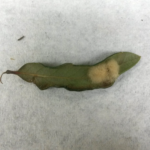
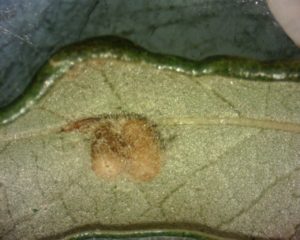
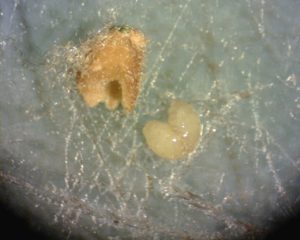
Left to right: the wooly gall; gall after wool is removed; developing insect inside of the gall
Gall makers can be visually identified by searching characteristics online, or let us do the work and submit a sample to the clinic! Learning to identify different galls can be a fun way to enjoy nature in your own yard.
More Oak Galls: Cynipid Wasp Galls, Hedgehog Gall, Vein Pocket Galls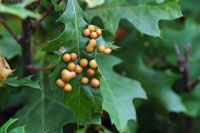
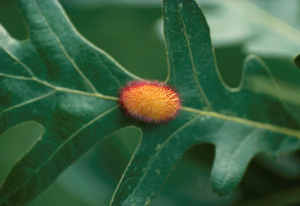
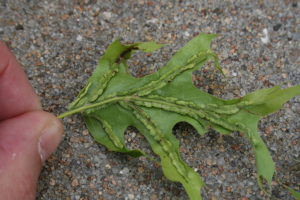
Photo Credit: J. Hahn, University of Minnesota (1,2); M. McKernan, Kansas State University (3)
Want to learn more?
WHAT Wednesday Galls Video
References
https://cdn-ext.agnet.tamu.edu/wp-content/uploads/2018/05/gall-making-insects-and-mites.pdf
https://agrilifeextension.tamu.edu/blog/2015/01/08/galls-oak-leaves/
https://agrilifeextension.tamu.edu/faqs/what-causes-galls-on-trees/
Photo Sources
https://apps.extension.umn.edu/garden/diagnose/plant/deciduous/oak/leavesbumps.html
https://blogs.k-state.edu/kansasbugs/2016/05/18/oak-vein-pocket-gall-back-with-a-vengeance/


